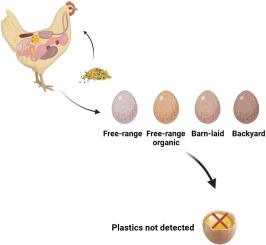解开鸡蛋中检测不到塑料的原因。
IF 8.1
2区 环境科学与生态学
Q1 ENVIRONMENTAL SCIENCES
引用次数: 0
摘要
据报道,几类食品中都含有不同浓度的塑料。本研究旨在澳大利亚首次定量调查商店购买的鸡肉鸡蛋中是否含有塑料。研究人员对三种常见品牌的土鸡蛋、有机土鸡蛋、厩肥鸡蛋和散养(自家饲养)鸡蛋样本中的七种常见聚合物(即聚丙烯、聚乙烯、聚氯乙烯、聚对苯二甲酸乙二醇酯、聚苯乙烯、聚甲基丙烯酸甲酯和聚碳酸酯)进行了分析。样品通过酶消化和加压液体萃取法提取,然后通过双枪微炉热解耦合气相色谱-质谱法进行定量分析。在分析的鸡蛋样本中,无论品牌和类别如何,均未检测到浓度超过检测限(LOD)的塑料(聚苯乙烯为 0.04 微克/克,聚氯乙烯为 0.22 微克/克),这表明澳大利亚人从食用鸡蛋中接触塑料的机会有限。 这项研究提供了宝贵的基准数据,并强调了在环境塑料污染日益严重的情况下,持续监测以确保食品供应的安全性和完整性的重要性。本文章由计算机程序翻译,如有差异,请以英文原文为准。

Unscrambling why plastics aren't detectable in chicken eggs
Several food groups have been reported to contain varying concentrations of plastics. This study was designed to quantitatively investigate for the first time in Australia the presence of plastics in store-bought chicken eggs. Three commonly consumed brands of free-range, free-range organic, barn-laid and backyard (home-laid) chicken egg samples were analyzed for seven common polymers (i.e., polypropylene, polyethylene, polyvinyl chloride, polyethylene terephthalate, polystyrene, poly-(methylmethacrylate) and polycarbonate). Samples were extracted by enzyme digestion and pressurized liquid extraction, followed by quantitative analysis through double-shot microfurnace pyrolysis coupled to gas chromatography-mass spectrometry. No plastics were detected at concentrations > limit of detection (LOD) (from 0.04 μg/g for PS to 0.22 μg/g for PVC) in the egg samples analyzed, regardless of brand and category, suggesting limited exposure of Australians to plastics from consuming eggs This study provides valuable baseline data and underscores the importance of continued monitoring to ensure the safety and integrity of food supplies in the face of rising environmental plastic pollution.
求助全文
通过发布文献求助,成功后即可免费获取论文全文。
去求助
来源期刊

Chemosphere
环境科学-环境科学
CiteScore
15.80
自引率
8.00%
发文量
4975
审稿时长
3.4 months
期刊介绍:
Chemosphere, being an international multidisciplinary journal, is dedicated to publishing original communications and review articles on chemicals in the environment. The scope covers a wide range of topics, including the identification, quantification, behavior, fate, toxicology, treatment, and remediation of chemicals in the bio-, hydro-, litho-, and atmosphere, ensuring the broad dissemination of research in this field.
 求助内容:
求助内容: 应助结果提醒方式:
应助结果提醒方式:


